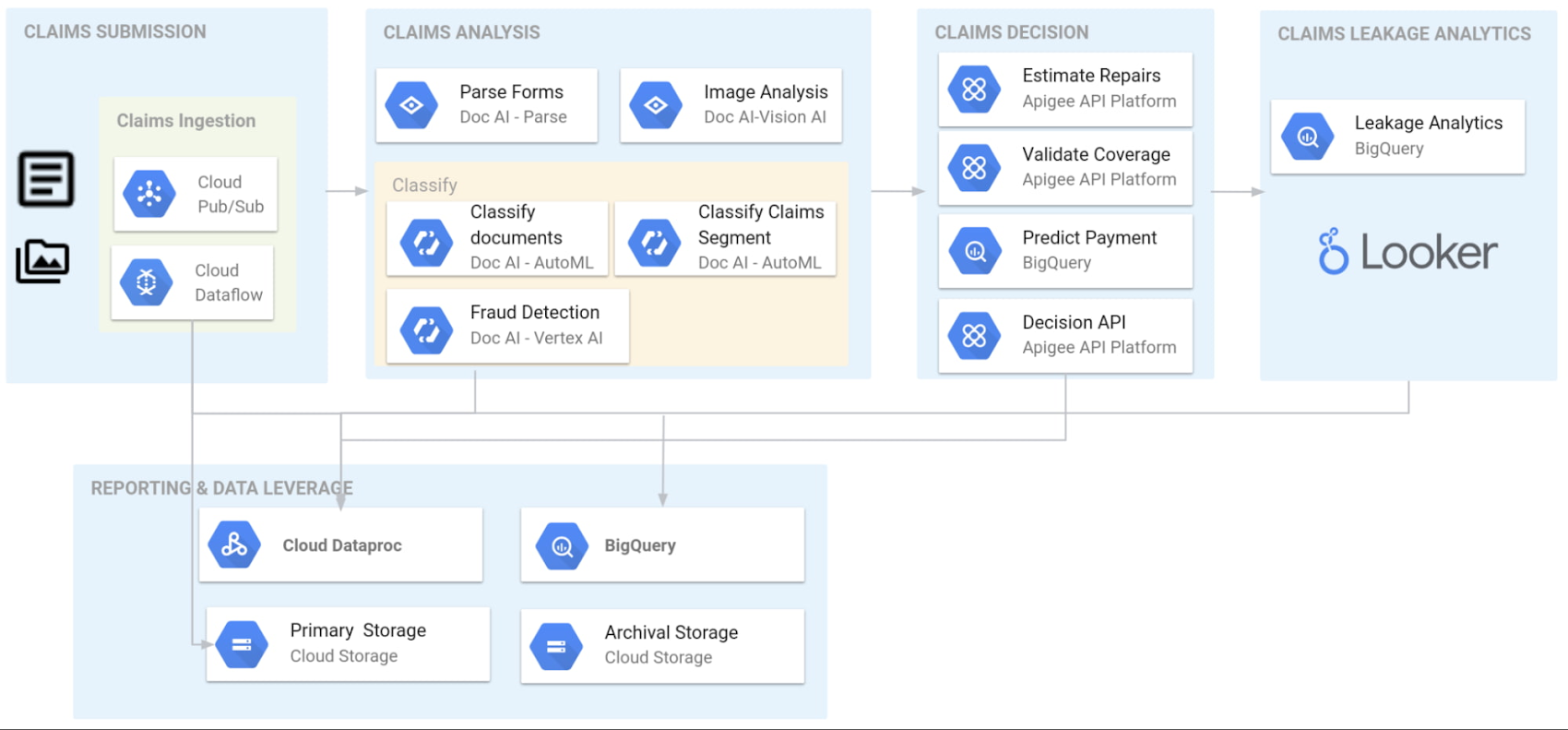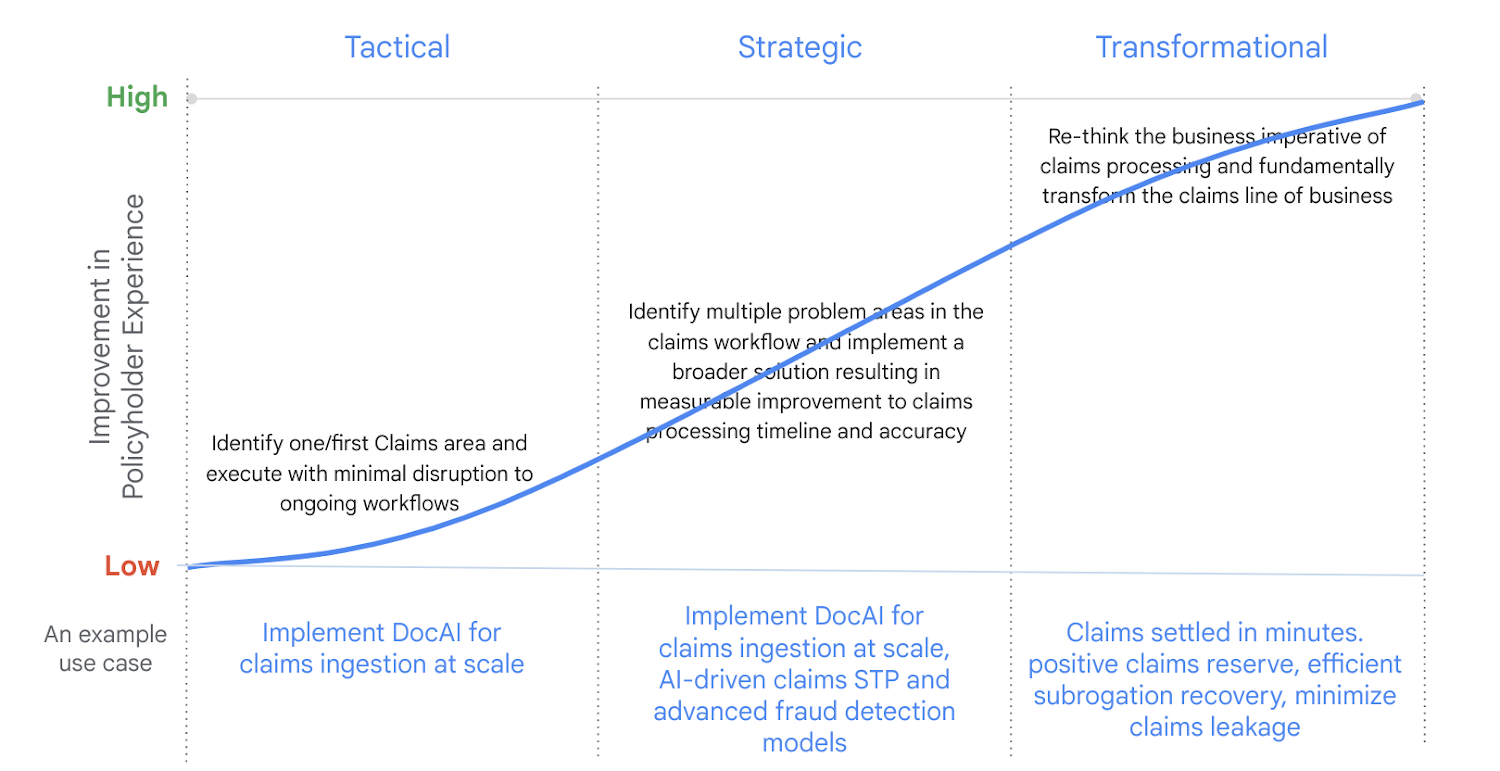A reference architecture for transforming insurance claims processing with Google Cloud
Kishore Gopalan
Principal Architect, Financial Services, Google Cloud
Anshu Kak
Head of Principal Architects, Distinguished Engineer, Google Cloud
Try Google Cloud
Start building on Google Cloud with $300 in free credits and 20+ always free products.
Free trialTransforming the customer experience of insurance claims processing is a key driver for transforming the insurance claims process itself. This needs a holistic approach to addressing different aspects of the claims processing workflow and modernizing the data that claims processing heavily relies on. Transforming claims processing can help reduce the manual touches from the process and lower processing time and costs, resulting in reduced claims’ payouts and higher policyholder satisfaction.
Studies by Verisk and Coalition Against Insurance Fraud show that auto insurers lose 14% of premiums a year due to claims leakage (about $29B). The annual cost of insurance fraud was as high as $60B and fraud occurs in about 10% of property-casualty insurance losses. Another study by PwC shows that 41% of customers are likely or more likely to switch providers due to a lack of digital capabilities. Inefficiencies in claims processing have a direct impact on the business and customer experience.
We describe how Google Cloud technologies working in unison through implementing the defined reference architecture can help organizations transform their Insurance claims processing to reap measurable business benefits and enhance the policyholder experience.
Introducing the Google Cloud insurance claims reference architecture
Google Cloud’s reference architecture for transforming insurance claims processing is available through the Google Cloud architecture diagramming tool (you can find it under Reference Architectures - Financial Services - Insurance Claims).
The reference architecture uses Google Cloud’s AI and data analytics platforms together with other Google Cloud technologies and supports the following use cases:
Claims submission / FNOL: Report claims online within minutes and enabling policyholders to upload claims documents at scale to the insurer’s app receiving the FNOL.
Claims assignment and analysis: Classify submitted documents, analyze images, perform claims segmentation.
Claims decision, repair analysis: Self-service damage assessment, real-time claims status, automated or quick settlement.
Claims leakage analytics: Analyze and report on claims data to assess and identify potential and actual claims leak.
Reporting and insights: Fraud monitoring, real-time insights into claims workflows, use claims insights in marketing and sales.
How to use the reference architecture


The reference architecture provides a framework for using Google Cloud to transform the insurance claims process holistically. The architecture can be implemented as-is in its entirety or addressed one function at a time.
Every insurance provider is in a different stage of their claims transformation journey, with a differing appetite to risk and unique budgetary needs. That’s why the reference architecture can be adopted in one of the following modes - Tactical (start small with prioritized functions), Strategic (identify multiple functional concerns and address them together for a measurable impact), Transformational (go big).


What can you achieve with the reference architecture?
The Google Cloud insurance claims reference architecture provides the following features:
Claims submission
Consume FNOL submission via any channel - forms, paper PDFs, scanned images.
Ingest the documents at scale for any form of claims data submission.
Perform inline data transformation to store data for near and long term.
Claims analysis
Advanced analytics to intelligently accelerate claims processing.
Parse form fields and tables from ingested documents.
Extract text from PDFs and images.
Use AI to classify claims documents, perform claims segmentation and run fraud detection models.
Asses damage in real time in claims scenarios requiring assessment of damage to property or vehicles.
Claims decisions
Make a decision on claims either automatically or significantly faster than today.
Validate claims, perform adverse selection modeling scenarios.
Estimate the cost of repair in damage assessment scenarios.
Predict payments and automatically settle claims in case of STP (straight through processing).
In case of non-STP, provide all necessary intelligence to associates to make a quick decision.
Claims leakage analytics
Analyze and report on claims data to assess and identify potential and actual claims leak.
Create models and visualizations to gain insights into several parameters like average settlement cost trends, number of reserve changes per claim, average time of first contact of claimant, subrogation recovery trends and more such analytics.
Reporting and data leverage
Store and unify content at scale, so it’s available when needed where needed and to whoever needs it.
Archive content for regulatory compliance at a fraction of the cost of primary storage.
Unify select claims insights and share them via APIs with internal teams, such as marketing or sales for more personalized offerings.
Transforming the claims processing workflow can provide multiple benefits, for example:
Faster multi-channel claims submission process and responsiveness can greatly increase customer satisfaction.
Data analytics and AI capabilities can create efficiencies that reduce the costs and increase the speed of claims adjustment.
Effective claims validation and management validation can improve the accuracy of claims’ payments.
Real-time insights can help cross-sell and up-sell insurance products based on policy holders’ needs.
Why transform insurance with Google Cloud
Further to the reference architecture we presented here, Google Cloud is uniquely positioned to transform an insurance business holistically. Here are a few technology enablers from Google Cloud that can aid in such a holistic transformation.
Google BigLake allows you to unify data from claims, underwriting and other insurance functions at scale, so it’s available to all lines of business including marketing and contact center.
Holistic data ecosystem that lets you build a datamesh to leverage data across various business lines like claims, underwriting and marketing with BigQuery for analytics, DataPlex to build a datamesh and Vertex AI for advanced AI and MLOps.
Google Earth Engine, a geospatial processing service, helps perform geospatial processing at scale, powered by BigQuery for property risk exposure assessment and portfolio management. For claims adjusters and underwriters, it provides an interactive platform for geospatial driven analytics.
Public datasets support claims analysts and actuaries for several scenarios including dynamic insurance pricing model using this dataset.




